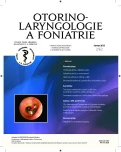-
Medical journals
- Career
Examination of Hearing in Newborns
Authors: K. Bartoňková; D. Hošnová
Authors‘ workplace: Lékařská fakulta Masarykovy Univerzity, Brno ; KDORL LF MU a FN Brno přednosta prof. I. Šlapák, CSc.
Published in: Otorinolaryngol Foniatr, 62, 2013, No. 2, pp. 73-77.
Category: Original Article
Podpora FN Brno, podpořeno MZ ČR – RVO (FNB, 65269705).
Overview
The publication is intended to present our experience with screening in pathological newborns. TEOAE (transient evoked oto-acoustic evoked emissions) provide a rapid and objective test of cochlear external hair cells in case of absent pathological changes in the middle ear. The examination is based on the experience that the healthy ear stimulated by a sound stimulus generates, by oscillations of external hair cells, sounds which are emitted via middle ear outside and can be therefore recorded and analyzed. The observed group is formed by patients who were admitted into the newborn intensive care units at the Faculty Hospital Brno. The TEOAE examination was performed in the years 2008-2011.
Timely detection of hearing loss decreases the risk of unfavorable impact of the hearing disorder to the development of the individual with the utmost efficiency. Timely detection of hearing defect depends on the screening organization, which the authors consider poor, and the subsequent follow up of the patients with established hearing defect.Keywords:
TEOAE examination, inborn hearing impairment, hearing defect, pathological newborns
Sources
1. Cristobal, R., Oghalai, J. S.: Hearing loss in children with very low birth weight: current review of epidemiology and pathophysiology, Arch. Dis. Child Fetal Neonatal, 93, 2008, s. 462-468, doi:10.1136/adc.2007.124214.
2. Cunningham, M., Cox, E. O.: Hearing assessment in infants and children: recommandations beyond neonatal screening. Pediatrics, 111, s. 436-440.
3. Harris, F. P, Probst, R.: Reporting click-evoked and distorsion-product otoacoustic emissions results with respect to the pure tone audiogram. Ear Hear, 12, s. 399-405.
4. Klozar, J.: Speciální otorinolaryngologie. 1. vydání, Praha, Galén, 2005, 224 s., ISBN 80-7262-346-X.
5. Kok, M. R. , Zanten, G. A. , Brocaar, M. P.: Aspects of spontaneous otoacoustic emissions in healthy newborns. Audiology, 32, s. 213-223.
6. Novák, A.: Audiologie. Unitisk, spol. s.r.o., 2003, s. 187-201.
7. Péčová, M., Jungwirtová, I.: Raná péče - malé ohlednutí zpět po deseti letech. Info-Zpravodaj 3/2011.
8. Valvoda, J.: Nedoslýchavost. Med. Pro Praxi, 4, 2007, 12, s. 514-518.
9. „Zdravá populace v r. 2010“, dokument vydaný ASHA (Americká asociace řeč - jazyk, sluch).
Labels
Audiology Paediatric ENT ENT (Otorhinolaryngology)
Article was published inOtorhinolaryngology and Phoniatrics

2013 Issue 2-
All articles in this issue
- Orbital Cellulitis in Childhood
- Examination of Hearing in Newborns
- Operation on Adhesive Otitis in Children
- Intranasal Administration of Lactobacillus Acidophilus in Children
- Thrombosis of Intracranial Sinuses in Children as an Acute Otitis Media Complication
- Downbeat Nystagmus at the Otorhinolaryngologist’s Office
- Otorhinolaryngology and Phoniatrics
- Journal archive
- Current issue
- Online only
- About the journal
Most read in this issue- Orbital Cellulitis in Childhood
- Thrombosis of Intracranial Sinuses in Children as an Acute Otitis Media Complication
- Downbeat Nystagmus at the Otorhinolaryngologist’s Office
- Operation on Adhesive Otitis in Children
Login#ADS_BOTTOM_SCRIPTS#Forgotten passwordEnter the email address that you registered with. We will send you instructions on how to set a new password.
- Career

